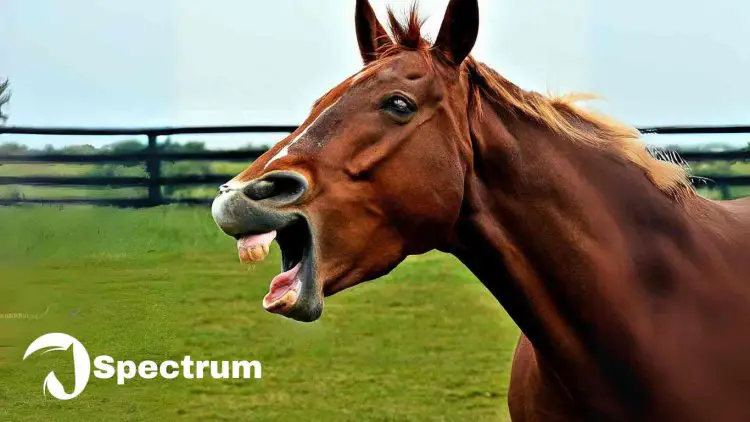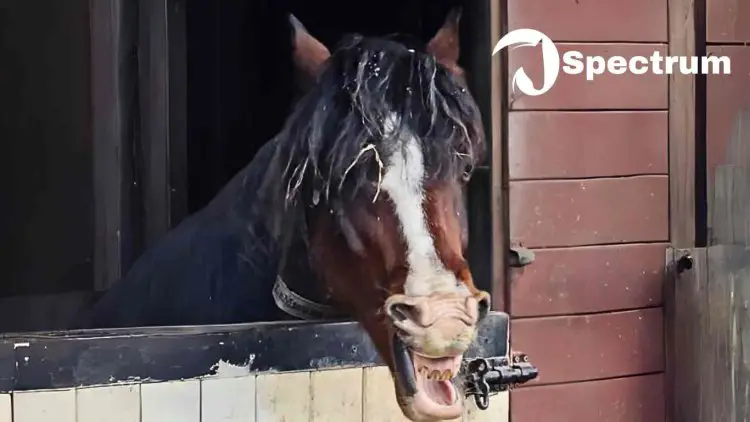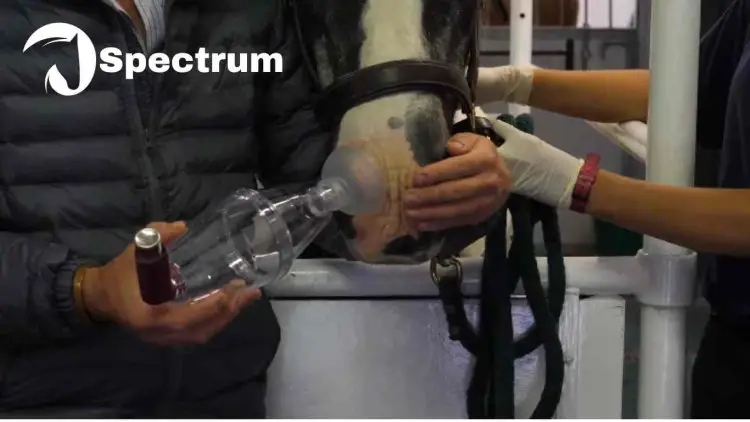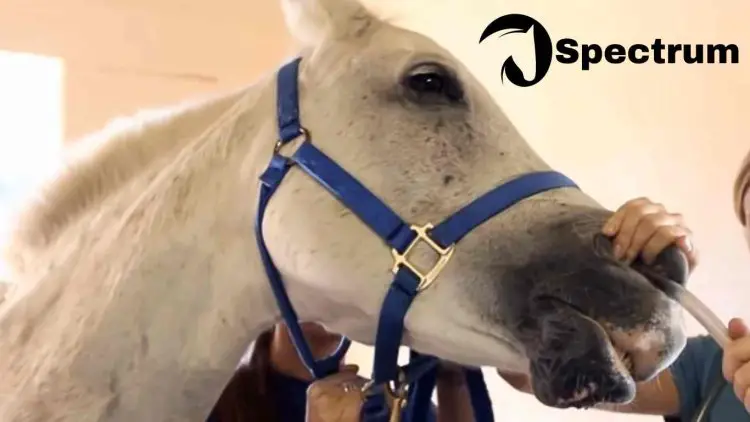Can You Ride a Horse With Heaves?
Can you ride a horse with Heaves? Heaves also known as Recurrent Airway Obstruction (RAO) is a respiratory disease that is caused by allergens found in the environment. In this article, you will get a detailed overview of equine heaves and how you can diagnose and manage heaves in horses. We will uncover different causes of heaves in equine and how you can save your horse from this allergic respiratory disease. We will also discuss how heaves affect the riding ability of horses and if a horse with heaves can still be ridden.

Table of Contents
Horses have long been companions to humans serving not only as working animals but as partners in various leisure activities like racing, jumping, and riding. However, horses like humans can suffer from health problems. One such condition is the issue commonly known as heaves or Recurrent Airway Obstruction (RAO) which is similar to asthma in humans. In this article, we will explore heaves and whether a horse with heaves can still be ridden.
What is Heaves in Horses?
Heaves is an inflammatory condition that affects horses. It is usually triggered by exposure to allergens found in their environment such as dust, mold spores, and other airborne particles typically present in barns or pastures. When horses inhale these allergens it can lead to symptoms like coughing, difficulty breathing, wheezing, allergy and allergic reaction, and increased respiratory effort. These symptoms may worsen during times of winter when horses are kept in poorly ventilated enclosed spaces.
Understanding the Condition

When a horse breathes in pollen grains or particles of dust or mold spores in its surroundings, it can initiate some inflammatory reactions within its respiratory system. This response often causes the airways to narrow down due to the presence of these allergens. This narrowing can cause symptoms like difficulty in breathing and ongoing coughing. The inflammation can even progress to the extent where severe cases show issues such as wheezing—a pitched whistling sound that occurs while breathing.
In some extreme cases, the horse may exhibit heightened breathing difficulty even when at rest indicating a greater struggle to breathe normally. These respiratory problems emphasize the influence that allergens can have on a horse's well being emphasizing the need to promptly manage and address these conditions to ensure the horse's overall health.
Diagnosing Heaves in Horses
Determining if a horse has heaves is a process that requires an evaluation from a qualified veterinarian. The diagnostic journey usually starts with an examination where the vet carefully assesses the horse's health and looks for specific symptoms related to heaves. To explore the system further common diagnostic tests are used. These tests include lung function tests to measure the horse's breathing capacity, blood tests to identify any signs of inflammation, and respiratory endoscopy, a procedure that uses a scope to examine the airway and detect any signs of inflammation or abnormalities. This careful approach helps the veterinarian gain an understanding of the horse's condition enabling them to make a diagnosis.
Managing Heaves with Medication
When managing heaves in horses veterinarians use an approach to help with breathing difficulties. One important part of the treatment is prescribing medications to reduce airway inflammation and improve function. Bronchodilators are commonly given to widen the air passages and allow for airflow while corticosteroids, like dexamethasone help to decrease inflammation in the system. Anti-inflammatory drugs are also employed to mitigate the inflammatory response, collectively working to promote easier and more comfortable breathing for horses grappling with heaves.
Can a Horse with Heaves be Ridden?
Many horse owners wonder whether a horse with heaves can still be ridden, considering the impact of the condition on the horse's breathing and overall health. While some horses with mild heaves can be ridden, caution and proper management are essential to ensure the horse's well-being.
Impact of Heaves on Riding
When horses suffer from heaves, their ability to breathe easily can be affected, and they may find it hard to keep up with vigorous activities like galloping or jumping. This condition can make them feel tired quickly, leading to reduced stamina. As a result, riders must be careful and aware of their horse's respiratory challenges. It's crucial not to ask the horse for activities that demand a lot of effort, as this might strain their breathing. Understanding and respecting the horse's limitations is key. Riders should opt for lighter exercises and give the horse enough time to recover after any physical exertion. By being considerate of the horse's well-being and adapting activities accordingly, riders contribute to maintaining the horse's health and ensuring a positive riding experience.
Feeding and Stall Management for Riding
Ensuring the well-being of horses involves careful attention to feeding practices and stall management, especially for those engaged in riding activities. Opting for low-dust hay and minimizing the use of dusty bedding are crucial steps to reduce the horse's exposure to allergens, promoting respiratory health. This is particularly important for horses susceptible to conditions like heaves, where airborne irritants can impact their breathing.
Moreover, the overall environment in the stall plays a pivotal role in the horse's comfort and, consequently, its suitability for riding. Regular cleaning to maintain a hygienic space and ensuring proper ventilation contribute significantly to alleviating heaves' symptoms. A well-ventilated stall allows for the circulation of fresh air, reducing the concentration of airborne particles that may trigger respiratory issues.
Related Posts: Can You Ridе a Horsе with Whitе Linе Disеasе?
Use of Inhalers for Riding Horses with Heaves

In managing horses with heaves, veterinarians may advise incorporating inhalers into the treatment regimen to administer the medication directly to the horse's airways. This targeted approach aims to alleviate breathing difficulties associated with heaves, enabling the horse to partake in light to moderate riding activities without imposing excessive stress on its respiratory system.
Utilizing inhalers, such as those equipped with equine inhaler devices, facilitates the delivery of aerosolized medications like beclomethasone dipropionate or other prescribed drugs. This method ensures the medication reaches the intended areas of the horse's respiratory system effectively.
How to Manage Severe Heaves in Horses?
For horses with severe heaves or frequent exacerbations, a comprehensive management approach is necessary to alleviate their symptoms and improve their quality of life. This may involve stronger medications and close collaboration with a veterinarian.
Use of Steroids and Other Medications
In cases of severe respiratory distress in horses, the utilization of systemic corticosteroids, such as prednisolone or dexamethasone, becomes imperative. Administering these medications under the close supervision of a veterinary professional, and in conjunction with other supportive treatments, is crucial to effectively control the horse's inflammatory response and prevent further respiratory complications. It is essential to recognize that the judicious use of these medications forms an integral part of a comprehensive treatment plan.
Consulting with a Veterinarian for Severe Heaves
Veterinarians assume a pivotal role in the comprehensive management of severe heaves in horses. Their expertise allows them to craft tailored treatment plans, closely monitor the horse's response to medication, and provide valuable insights into necessary dietary adjustments and environmental modifications. Collaborating with a veterinarian ensures a holistic approach to mitigating the impact of allergens on the horse's respiratory health, promoting overall well-being.
Supplements and Pasture Management
Complementing medication, dietary supplements like Omega-3 fatty acids sourced from flaxseed can play a significant role in alleviating inflammation and supporting optimal respiratory function in horses dealing with severe heaves. Concurrently, effective pasture management strategies, including minimizing exposure to dusty or moldy environments, are imperative. By implementing these measures, horse owners contribute significantly to reducing the horse's susceptibility to allergens and fostering a healthier respiratory state.
Diagnosis of Heaves in Horses
The identification and diagnosis of heaves in horses necessitate a multifaceted approach. This involves a thorough assessment of the horse's clinical signs, the conduct of specific tests, and the formulation of a comprehensive treatment plan to effectively manage the condition. Accurate diagnosis lays the foundation for targeted and successful intervention.
Identifying Recurrent Airway Obstruction (RAO)
Previously referred to as heaves, Recurrent Airway Obstruction (RAO) manifests as recurrent episodes of respiratory distress and coughing due to airway inflammation and constriction. Recognizing the clinical manifestations of RAO is pivotal for prompt intervention and the effective management of the condition. This understanding facilitates timely and appropriate care, ensuring the horse's well-being.
Common Tests for Diagnosing Heaves

Veterinarians may perform lung function tests, such as bronchoalveolar lavage or pulmonary function testing, to assess the severity of airway inflammation and to guide the selection of appropriate medications. Blood tests may also reveal elevated inflammatory markers, supporting the diagnosis of heaves.
Prescription and Dosing for Heaves
Once heaves is diagnosed, the veterinarian will prescribe the necessary medications and determine the appropriate dosing based on the horse's weight, the severity of the condition, and the desired therapeutic response. It's essential for horse owners to adhere to the prescribed regimen and monitor their horse's progress regularly.
Understanding the Triggers and Management of Heaves
To effectively manage heaves in horses, it's crucial to identify the common triggers and implement proactive measures to mitigate the horse's exposure to these allergens, thereby minimizing the frequency and severity of respiratory episodes.
Identifying Common Allergens in the Barn
Dust, mold spores, and airborne particles from hay and grain are among the common allergens found in the barn environment that can exacerbate heaves in horses. Implementing strategies to reduce the presence of these allergens, such as proper ventilation and dust control measures, can significantly improve the respiratory comfort of affected horses.
Medication and Bedding Management for Heaves
Avoiding dusty bedding materials and incorporating low-dust alternatives, such as straw or shredded paper, can help minimize the inhalation of airborne particles that trigger respiratory distress in horses with heaves. Regular stall cleaning and proper ventilation also play a vital role in reducing allergen exposure.
Impact of Dust and Mold on Heaves in Horses
The presence of dust and mold in the horse's environment can exacerbate the symptoms of heaves and contribute to chronic respiratory inflammation. Minimizing the accumulation of dust and mold through routine barn maintenance and using high-quality hay and feed can create a healthier environment for horses prone to respiratory conditions like heaves.
What's Your Reaction?

















